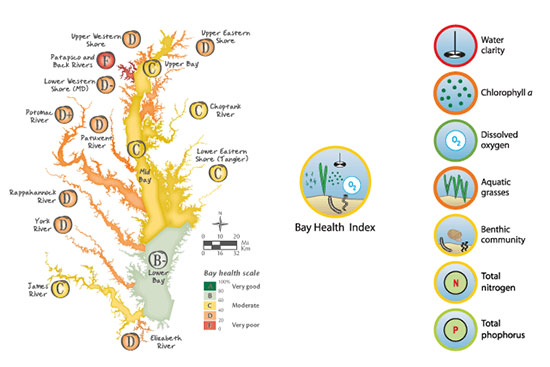University of Maryland report card measures improvement in Chesapeake Bay health
Up from a D+ in 2011, the 2012 Bay Health Index is 47 percent.
Scientists at the University of Maryland Center for Environmental Science (UMCES) have measured an improvement in Chesapeake Bay health, giving the estuary a “C” in its latest Chesapeake Bay Report Card.
Up from a “D+” in 2011, the Bay Health Index of 47 percent takes into account seven indicators of Bay health, including water clarity and dissolved oxygen; the amount of algae, nitrogen and phosphorous in the water; the abundance of underwater grasses; and the health of the benthic or bottom-dwelling community. While underwater grasses continued to decline, the rest of the indicators improved in 2012.

Image courtesy EcoCheck/Integration and Application Network
“I’m cautiously optimistic about the health of the Chesapeake Bay,” said UMCES Vice President for Science Applications and Professor Bill Dennison in a media release. “We are seeing progress in our efforts to reduce nitrogen and phosphorous levels. In addition, water clarity, which had been declining, has leveled out—and may even be reversing course.”
According to the report card, these improvements are due to a number of weather events. While excess rainfall can push nutrient and sediment pollution into rivers and streams, a dry summer in 2011 led to improvements in water clarity and dissolved oxygen and the favorable timing and track of Superstorm Sandy meant the storm did less damage to the Bay than some feared.
Learn more about the 2012 Chesapeake Bay Report Card.

Comments
There are no comments.
Thank you!
Your comment has been received. Before it can be published, the comment will be reviewed by our team to ensure it adheres with our rules of engagement.
Back to recent stories